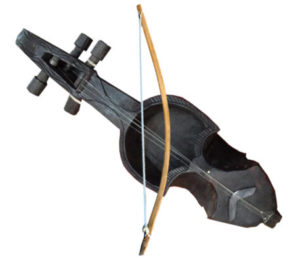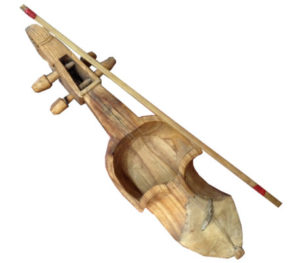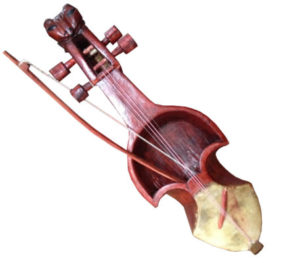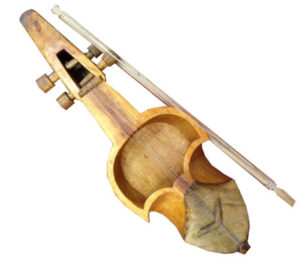Your cart is currently empty!
Author: admin
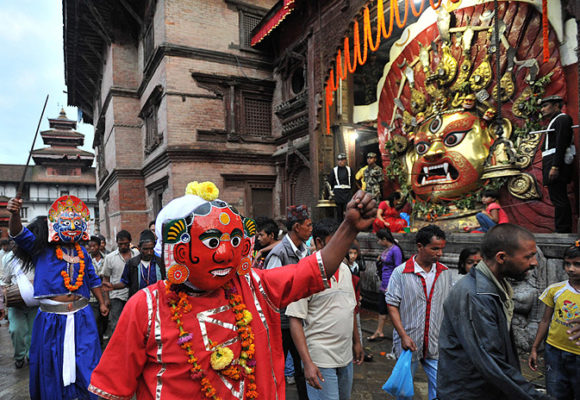
Indra Jatra | An overview on Indra Jatra Festival

Indra is Lord of Rain and the king of Heaven. Jatra is procession. Indra Jatra is celebration of God Indra’s Day. Indra Jatra is festival of Kathmandu, the capital of Nepal. Some believes Indra Jatra is thanking day to lord Indra for the rain. According to others, the festival is celebrated in the honor of Bahirab, who is Shiva’s manifestation and is believed to destroy evil.
ईन्द्र जात्रा ( INDRA JATRA )
When do we celebrate Indra Jatra
Indra Jatra begins every year from the day of the Bhadra Dwadasi to Ashwin Krishna Chaturdasi. It is a eight day long festival.
How do we celebrate Indra Jatra
The festival begins with the carnival-like erection of The Linga (Yasingh), a ceremonial pole, accompanied by the rare display of the deity Akash Bhairab, represented by a massive mask spouting Jaad and raksi (Nepali local liquors). Households throughout Kathmandu (especially Newars) display images and sculptures of Indra and Bhairab at this time of year. This thirty-six feet long wooden pole (The Linga (Yasingh)) is chosen with great care from the Nala forest in Kavre district east of Kathmandu.
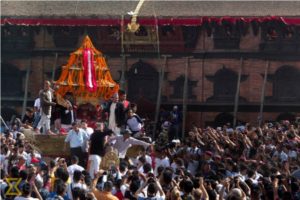
According to traditional beliefs, Indra had received this flag from Lord Vishnu for protection.
Finally, the Kumari (living goddess), leaves the seclusion of her temple in a palanquin and leads a procession through the streets of Kathmandu to thank Indra the rain god. The main attraction of the festival is the procession of chariots and masked dancers representing deities and demons. Indra is called Yanya in Newari. Jaad (Nepali local liquor) flows from the Bahirab statue, which is remarkable to look at in Hanuman Dhoka.
The procession consists of:
• Majipa Lakhey
• Pulukishi
• Sawan Bhaku
• Ganesh (Chariot)
• Kumar (Chariot)
• Kumari (Chariot)Besides these, there are various dances held on the open stages of the city called dabu. There is display of Swet Bhairava as well as various deities of the city.
Story Behind Indra Jatra
Indra’s mother needed parijat, a type of flower, for some religious ritual so Indra disguised as a human being came to the earth to fetch them. But, he was recognized when he was to steal the flowers so the people caught him and tied him with ropes. The statue of which is still worshipped in Maru Tole in Kathmandu. This image is also put on display with others in different parts of the city during Indra Jatra festival.
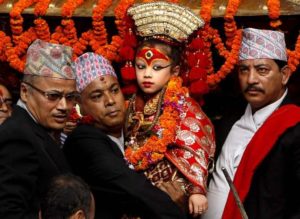
Indra Jatra is a very interesting festival because for the whole week people enjoy various traditional dances and witness the chariot of Goddess Kumari, Lord Ganesh and Lord Bhairav being pulled through the older parts of the Kathmandu city. A day has been added to the original seven days of celebration and on that day known as Nanicha yaa the chariots are pulled through Naradevi, Nhyokha, Ason, Indrachwok and Hanuman Dhoka. This extra day of chariot pulling was introduced by King Jaya Prakash Malla in 1765 B.S.
In Indra Chowk, the famous Akash Bhairava bust is displayed and it is decorated with flowers. This Akash Bhairava’s head is related to the Mahabharata story. Some believe it to be the head of the first Kirat King Yalamber. In Indra Chowk, every night different groups gather and sing bhajans and hymns.
During Indra Jatra, there are a variety of performances including the dances of Sawa Bhakku Bhairav from Halchowk, Majipa Lakhey from Majipat, Devi Nach and Yeravat hathi (Pulukisi) from Naradevi, Mahakali and Kathi Maka Nach from Bhaktapur. All the dances take place around Hanuman Dhoka area. The Dasavatar or the ten incarnations of Lord Vishnu is also staged every night.
The first day of the festival is also observed by the Newars as a day to remember the family members who died during the past year by offering small oil lamps along a traditional route covering all the parts of the old city. It is believed to have been started during the reign of Mahendra Malla.
The Linga (Yasingh) is pulled down signalling the end of Indra Jatra festival. It is taken to the confluence of Bagmati and Bishnumati in Teku to be put to rest.
The end of the Indra Jatra festival heralds the beginning of Dashain and Tihar celebrated with great enthusiasm not only in the Kathmandu Valley but throughout the country.
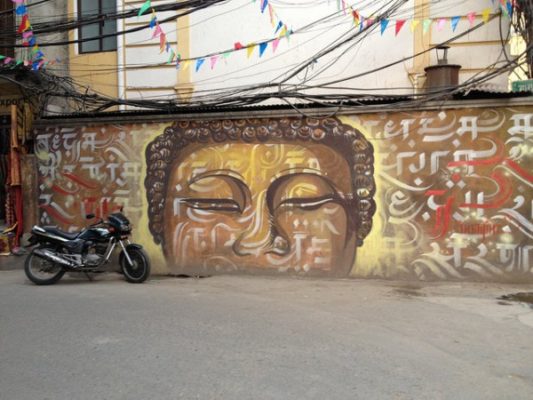
Nepali Art: Sources of Art
Art
The art and culture of Nepal have been strongly influenced by the religious beliefs of the country. The artwork is decorative, delicate, and very beautiful. Nepal art is strongly influenced by the culture of the people and the two really go together and are interwoven. The two most typical forms of art are paintings and sculptures. Nepal’s art and culture have changed little over the centuries through western influences are slowly starting to affect some modern artists.
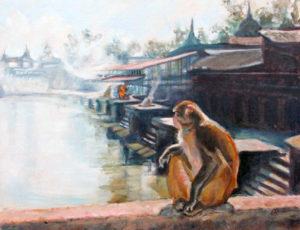 Painting
PaintingThe earliest examples of Nepalese art in painting form is that of manuscript illustrations found on palm leaves. This tradition goes far back into the past and the earliest known illustrated manuscript is the Astasahasrika Prajnaparamita of 1015 AD. Often the wooden covers which were created to protect the manuscript-painted leaves are more lavishly decorated than the actual manuscript. Many examples of this type of art have survived and are well preserved. The influence that religion has on such artwork is evident in the fact that such manuscripts are usually only decorated with figures Nepal Painting of divinities. All the manuscripts are illustrated with images of gods and goddesses, regardless of whether they are Buddhist or Hindu in origin. Oftentimes certain manuscripts – along with the relevant imagery – would be copied and donated to a monk, priest, monastery, or temple. Thus the style of painting remained fairly constant and painting quality was maintained for a long period of time. The quality of paper manuscripts also declined. Due to this, older paintings are now held in higher regard than more modern manuscripts of lower quality.
Another form of painting that is evident in Nepal since ancient times is the Thangka Paintings. These were primarily religious in nature and were used as icons in worship. These paintings are known as Paubha in Newari and Thangka in Tibetan and originated in Nepal. The creation of illuminated wall paintings or religious metal sculptures was in big demand at one stage and this spawned an ‘industry’ of skilled artisans who catered to the demand by initiating the painting of such icons on cloth which could be rolled up and easily transported. These thangka paintings were widely received with praise and thus made their way into homes and monasteries in the ninth century and are still popular today. A good example of a thangka painting is the ‘Mandala of Vishnu’ which dates back to 1420 AD. Early thangkas are simple in design and consist of a centrally positioned large deity surrounded by smaller figures of lesser importance. From the 15th century, the Tantric cult started to take hold of the people of the land. Artists started to use brighter colors and there was a tendency towards the portrayal of Shiva and Shakti in various conventional poses. Because of the esoteric nature of Tantrism, a strong emphasis was put on the female element and sexuality during this time. The thangkas produced were said to possess magic forces and a great variety of symbols were incorporated into the artwork.
Sculpture
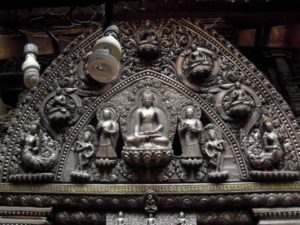 The sculpture has enjoyed a long and interesting history in Nepal and many carved artifacts have been found in the Terai region of the country. All early sculptures were religious in nature and the artists themselves also seemed to be extremely devoted to their various deities. While early sculptures were very simple, but those from the Lichchhavi period were strikingly beautiful. These sculptures were made from stone, copper, and bronze and depict round faces and slanted eyes. There is a lot of attention to detail while still presenting the deity in a simplistic way. The use of clothing and ornaments were always kept to a minimum and often the subject wears only a Dhoti or Sanghatis. The Lichchhavi period (5-8 CE) was the Golden Age of Nepalese sculpture and many excellently excavated and preserved examples can be found. Woodcarving, while not always in ornamental form, also served a decorative purpose in ancient Nepal and thus is viewed as an art form. Windows, doors, temples, roof-struts, and numerous artifacts were all carved by hand and can be still seen in the Katmandu valley. Wood is not as long-lasting as a stone and so Sculptures in Nepal examples do not date back further than the 14th century yet wood carving continues to be a very prominent aspect of Nepalese architecture. Nepalese artwork had far-reaching effects on other cultures. The first major introduction of local art to other cultures occurred in the 7th century AD when Mahayana Buddhism was introduced in Tibet under the order of king Angshuvarma. A large number of monasteries were subsequently built and these all needed to be filled with manuscripts and sculptures. Today some of the most outstanding examples of Nepalese art can be found in Tibet. Nepal’s artistic influence even cross the borders of China when Nepalese artisans were sent to the courts of Chinese emperors to impart their knowledge to local craftsmen and to create artworks. The most exemplary contribution of this nature was made by the innovator and architect Balbahu or ‘Arniko’, who’s many creations can still be found to this day.
The sculpture has enjoyed a long and interesting history in Nepal and many carved artifacts have been found in the Terai region of the country. All early sculptures were religious in nature and the artists themselves also seemed to be extremely devoted to their various deities. While early sculptures were very simple, but those from the Lichchhavi period were strikingly beautiful. These sculptures were made from stone, copper, and bronze and depict round faces and slanted eyes. There is a lot of attention to detail while still presenting the deity in a simplistic way. The use of clothing and ornaments were always kept to a minimum and often the subject wears only a Dhoti or Sanghatis. The Lichchhavi period (5-8 CE) was the Golden Age of Nepalese sculpture and many excellently excavated and preserved examples can be found. Woodcarving, while not always in ornamental form, also served a decorative purpose in ancient Nepal and thus is viewed as an art form. Windows, doors, temples, roof-struts, and numerous artifacts were all carved by hand and can be still seen in the Katmandu valley. Wood is not as long-lasting as a stone and so Sculptures in Nepal examples do not date back further than the 14th century yet wood carving continues to be a very prominent aspect of Nepalese architecture. Nepalese artwork had far-reaching effects on other cultures. The first major introduction of local art to other cultures occurred in the 7th century AD when Mahayana Buddhism was introduced in Tibet under the order of king Angshuvarma. A large number of monasteries were subsequently built and these all needed to be filled with manuscripts and sculptures. Today some of the most outstanding examples of Nepalese art can be found in Tibet. Nepal’s artistic influence even cross the borders of China when Nepalese artisans were sent to the courts of Chinese emperors to impart their knowledge to local craftsmen and to create artworks. The most exemplary contribution of this nature was made by the innovator and architect Balbahu or ‘Arniko’, who’s many creations can still be found to this day.Stupa Style
 A Nepalese architectural style is borne out of Buddhist concepts and used in the construction of Buddhist shrines. Stupa architecture is easy to spot. A square base is mounted upon a hemispherical structure. Atop the strong base is thirteen rings layered on top of each other and progressively narrowing to a point. A parasol tops it all off. The square bases, also known as Harmika has pairs of “all-seeing” eyes painted on each of its exposed sides. Swayambhu Shrine and Baudhanath Shrines, declared World Heritage Sites by UNESCO, are exquisite examples of the stupa style. In Patan, you will discover some of the oldest stupas in Nepal that were commissioned by King Ashoka.
A Nepalese architectural style is borne out of Buddhist concepts and used in the construction of Buddhist shrines. Stupa architecture is easy to spot. A square base is mounted upon a hemispherical structure. Atop the strong base is thirteen rings layered on top of each other and progressively narrowing to a point. A parasol tops it all off. The square bases, also known as Harmika has pairs of “all-seeing” eyes painted on each of its exposed sides. Swayambhu Shrine and Baudhanath Shrines, declared World Heritage Sites by UNESCO, are exquisite examples of the stupa style. In Patan, you will discover some of the oldest stupas in Nepal that were commissioned by King Ashoka.Shikhara Style
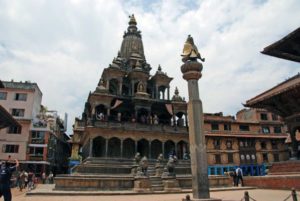 Nepal’s Shikhara style consists of 5 or nine vertical sections forming a high pyramidal or curvilinear tower-like structure. The apex is bell-shaped. This style is not very common, but a fine example can be seen in Patan, it is the Krishna temple.
Nepal’s Shikhara style consists of 5 or nine vertical sections forming a high pyramidal or curvilinear tower-like structure. The apex is bell-shaped. This style is not very common, but a fine example can be seen in Patan, it is the Krishna temple.Architecture
The magnificent architecture of Nepal is a form of art that truly captures the culture and essence of Nepal. Traditional Nepalese architecture attracts both tourists and scholars to this amazing country. The fascinating historical buildings and unique Nepalese architectural designs inspire much awe. Particularly popular is Bhaktapur where tourists can explore numerous outstanding Nepalese architectural structures. Certain people have divided Nepal’s architecture into three non-specific stylistic groups, namely Pagoda style, stupa style, and shikhara style.
Pagoda Style
 This Nepalese architectural style features several layered roofs that have broad eaves carefully held up by carved wood struts. The building’s roof is typically crowned by triangular spires surrounding upside-down bell made out of burnished gold. Windows on Nepal Temple-Architecture the structure protrudes and is usually latticed. The pagoda style is a true demonstration of fine artistic architectural design. Interestingly, China later borrowed the style which further spread through Asia. Pay a visit to Kasthamandap in the Kathmandu Valley to view an impressive wooden pagoda constructed during the Malla age. Another spectacular example of this intriguing Nepalese architectural style is Basantpur Palace, a nine-story structure commissioned by King Prithvi Narayan Shah. Also make your way to the temples of Pashupati, Changu Narayan, and Taleju.
This Nepalese architectural style features several layered roofs that have broad eaves carefully held up by carved wood struts. The building’s roof is typically crowned by triangular spires surrounding upside-down bell made out of burnished gold. Windows on Nepal Temple-Architecture the structure protrudes and is usually latticed. The pagoda style is a true demonstration of fine artistic architectural design. Interestingly, China later borrowed the style which further spread through Asia. Pay a visit to Kasthamandap in the Kathmandu Valley to view an impressive wooden pagoda constructed during the Malla age. Another spectacular example of this intriguing Nepalese architectural style is Basantpur Palace, a nine-story structure commissioned by King Prithvi Narayan Shah. Also make your way to the temples of Pashupati, Changu Narayan, and Taleju.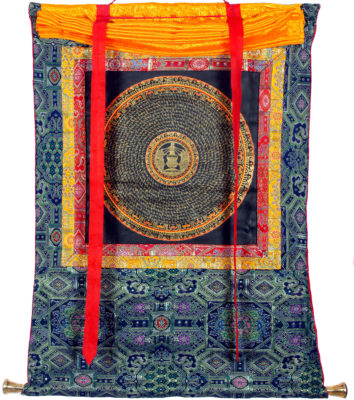
A Brief to Thangka
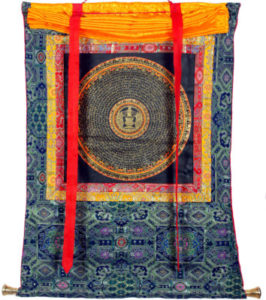 Thangka is a silk painting with embroidery, usually showing a Buddhist god, famous scene, or a mandala. The Thangka is very different than regular oil or acrylic painting. It is a piece of the picture which is painted or embroidered, over which fabric is attached, and then over which is laid a cover, usually silk. Generally, Thangkas last for a very long tenure. It is delicate and hence, should be stored in dry places. Moisture is not at all good for it. Thangka is also known as scroll- painting.
Thangka is a silk painting with embroidery, usually showing a Buddhist god, famous scene, or a mandala. The Thangka is very different than regular oil or acrylic painting. It is a piece of the picture which is painted or embroidered, over which fabric is attached, and then over which is laid a cover, usually silk. Generally, Thangkas last for a very long tenure. It is delicate and hence, should be stored in dry places. Moisture is not at all good for it. Thangka is also known as scroll- painting.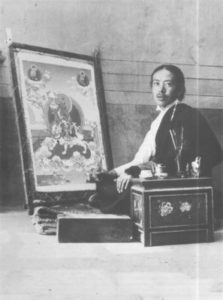
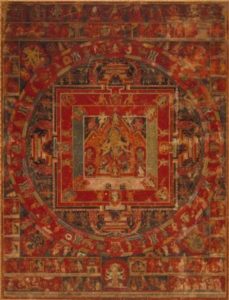
Origin and Purpose of Thangka
A thangka is a Nepali form of art exported to Tibet by princess Bhrikuti ( Harit Tara – daughter of Ansuvarma) of Nepal (7thCentury) married to Sron Tsan Gampo, the then ruler of Tibet. The word “Thangka” is believed to have come from the Tibetan word “Thang Yig” meaning a written record.
Originally, Thangka paintings became popular among travelers and monks as a teaching tool to illustrate the life history of Gautam Buddha, lamas, another god/goddesses, and Bodhisattvas. One of the most popular subjects seen in Thangkas is “The wheel of life” which is the visual representation of Abhidharma teachings or the art of enlightenment. These religious paintings offer a beautiful expression of both being visually and mentally inspiring.
Thangka is the most bought product by travelers as gifts from Nepal.
Types of Thangka
Based on the technique and materials of painting Thangkas can be grouped by types. Generally, they are divided into two broad categories: those that are painted (Tib.) bris-tan—and those made of silk, either by appliqué or embroidery
Thangkas are further divided into specific categories:
- Painted in colors (Tib.) tson-tang—the most common type
- Appliqué (Tib.) go-tang
- Black Background—meaning gold line on a black background (Tib.) nagtang
- Blockprints—paper or cloth outlined renderings, by woodcut/woodblock printing
- Embroidery (Tib.) tshim-tang
- Gold Background—an auspicious treatment, used judiciously for peaceful, long-life deities and fully enlightened buddhas
- Red Background—literally gold line, but referring to a gold line on a vermillion (Tib.) mar-tang
Check our wide collection of Nepali Thangka Paintings
Typical Thangkas are fairly small, between about 18 and 30 inches tall or wide, there are also giant festival Thangkas, usually Appliqué, and designed to be unrolled against a wall in a monastery for particular religious occasions. These are likely to be wider than they are tall, and maybe sixty or more feet across and possibly twenty or higher.
Thangka Paintings
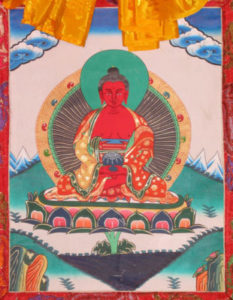
Thangkas are painted on cotton or silk. The most commonly used are loosely woven cotton produced in widths from 40 to 58 centimeters (16 – 23 inches). While some differences do exist, Thangkas wider than 45 centimeters (17 or 18 inches) normally have layers in support. The paint consists of water-soluble dyes. Both mineral and organic pigments are used, hardened with herb and glue solution. In Western terminology, this is adistempertechnique.
The composition of a Thangka, as with the popular Buddhist art, is highly logical. Arms, legs, eyes, nostrils, ears, and various ritual implements are all arranged out on a systematic web of angles and intersecting lines. A skilled Thangka artist will usually select from a range of predesigned items to include in the masterpiece, extending from alms bowls and animals to the shape, size, and angle of a figure’s eyes, nose, and lips. The procedure seems well-disciplined, but often requires a deep understanding of the imagination involved to capture the spirit of it.
Making of Thangka
There are different kinds of Thangka employing various canvases. However, most are painted on cloth or paper. The white cloth is first mounted on a frame and water-based colloid chalk is applied to the surface. It is polished with talc when dried. The canvas is thus ready for painting. Apart from this, there are Thangka which are webs of embroidery, woven silk, silk tapestry, or appliqué. Embroidered Thangkas are done with multi-colored silk threads. Silk woven Thangka takes the warp of brocade as the base and applies the method of jacquard weaving with colored silk threads as the weft.
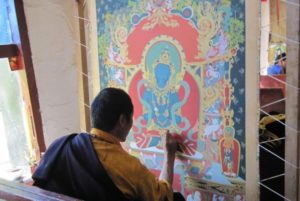
Making of Thangka With appliqué Thangka, human figures, designs, and patterns are cut out of colored satin and glued onto the canvas. The resulting work is also called “embossed embroidery.” Tapestry Thangka is woven with the method of “complete warps and broken wefts: which calls for the application of the weft threads on the warp only where the picture or design needs it. The “hollowed out” work produces a three- dimensional effect. Tapestry Thangka is thick, closely woven, delicately designed, and gorgeously decorated with colored silk threads. There is yet another kind of Thangka in which beautifully designed colored fabrics decorated with pearls and precious stones are attached to the fabric with gold thread thereby creating a resplendent and dazzling effect.
Method
- Line drawing is created with complete accuracy, proportion, and detail, of the deity or desired image.
- Then portions of the drawing are transferred by tracing to the silks that will be used in the final piece.
- Definition of line details is created by rolling silk thread over the cord and then by carefully hand-stitching this to the silk pieces.
- The pieces are then cut out and edges turned under and ironed. Piece by piece the image is created with all its detail.
- Features such as eyes, jewels, and flowers are masterfully stitched using special embroidery techniques.
- Next, the individual pieces are joined together, first using glue and then stitched along every edge so that the pieces form the completed image.
- Lastly, there are some finishing stitches, and additions of gems such as Tibetan turquoise and coral are added.
- The image is then framed in silk brocade.
Thangka often overflows with imagination and reference. Because the art is clearly religious, all symbols and references must be in accordance with strict guidelines laid out in Buddhist scripture. The artist must be properly trained and have sufficient religious understanding, knowledge, and background to create precise and correct Thangka.
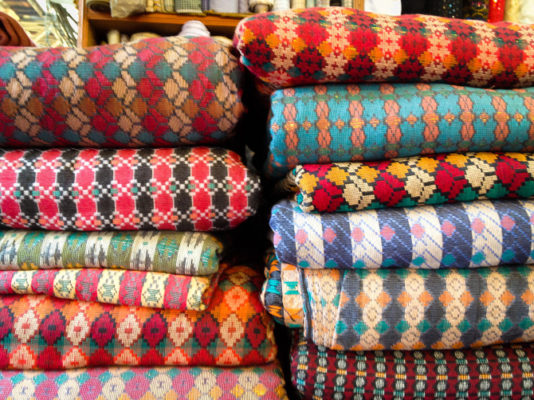
Dhaka Topi and Fabric
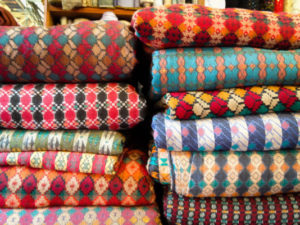
Nepali Dhaka Prints What are topis anyway? Are they a symbol of honor, a basic fabric of culture, or an utterly exaggerated form of clothing
Each culture that’s proud of its existence has pieces of clothing with stories that go back into the past. A veil or a scarf. A meager hairpin or an exaggerated gown. When it comes to Nepal, there is nothing that can explain our history as clearly as the Nepali topi.

A Nepali Dhaka Topi Seller Nepali topi or Dhaka Topi has been adorning Nepali heads for generations. This unusually cut piece of clothing is a way of life for many older people. Even youngsters find it important to adopt a topi on formal occasions. Intrigued to know its history, I went to Ason, probably the only place where I could find answers.
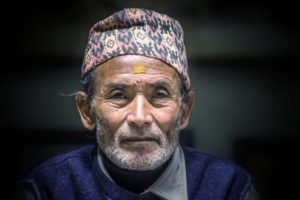
A Nepali Old Man Wearing a Dhaka Topi Nirmal Tuladhar took over the shop of hats from his father in 1976 but it has been there in the same place since his grandfather’s time, for probably more than 75 years, making it one of the oldest Dhaka Topi shops in Nepal. “We had people from all over Nepal come here. At a time when it was difficult to find good quality topis, ours was probably the only one people trusted. Things have not changed much. We are still revered as the oldest topi shop in Nepal,” says Nirmal Tuladhar.
Dhaka Topi got its name from the fabric that was imported from Dhaka in Bangladesh. Although these materials are no longer brought in from Dhaka, old shawls are still cut to make these Topies that are appreciated for their rarity and history. “Dhaka Topis are expensive. They are rare and of very good quality. Only one in a million wear these,” says Nirmal Tuladhar, smiling.
The store itself has changed over the years and has adopted modern hats along with Nepali topis. But the highlight of the place still remains the Bhaktapur-made Bhadgaule topi and Dhaka Topi.
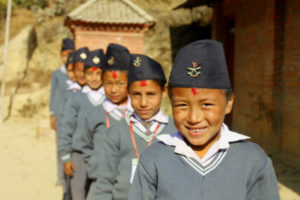
Bhadgaule Topi “Topis are strongly attached to our culture. My father gave them away for free when King Mahendra passed away. I still remember that day. Even something as simple as the way you wear a topi represents the status you have in society. Kings wore it in a more different manner than the common people. It is a huge part of our culture and the time that was,” shares Nirmal.
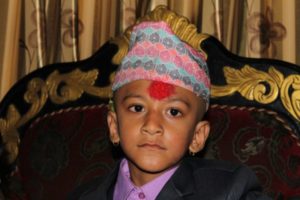
A Nepali Kid Wearing a Dhaka Topi During Dashain From stories of Kings’ demises to the actual interaction among people on the latest trends of Nepali topis, it wouldn’t be wrong to say that these hats have witnessed more events than any other form of clothing. “People from different political parties have different ways of wearing the topis as well. I have many who buy theirs from my place,” says Nirmal. His statement only apprises us about how our history is still being created as we speak. We can only hope this symbol of pride can shine on for a long time on the heads of the Nepalese.
image sources: flicker/wikimedia
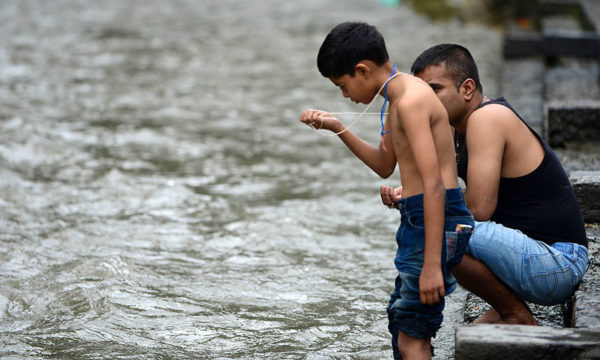
Janai Purnima: The Thread Festival
Janai Purnima, the thread festival, falls on the full moon day in the month of Bhadra (August/ September) and is celebrated with great gusto, devotion, and splendor by Hindus all over the country.
A Janai is a sacred thread and Purnima is a full moon day, hence, Janai Purnima points to the change of the thread on the auspicious full moon day. On this day, the Tagadharis (Hindu men wearing the sacred thread), especially the Brahmins and Chettris performing their annual change of Janai (sacred yellow cotton thread) slung from the shoulder and also tie Tago (sacred thread) sanctified by priests chanting the Gayatri Mantra as a symbol of protection. The Janai is given to Hindu men in a coming-of-age ceremony called Bratabandha that initiates them into manhood and commands them to faithfully follow the religion. It must be worn every day of their lives from this day onwards. The triple cord of Janai is a symbol of body, speech, and mind, and when the knots are tied the wearer is supposed to gain complete control over each. After taking bath and making offerings to the Saptarishis (seven legendary Rishis or sages) and to their departed fathers and fore-fathers, the Tagadharis put new Janai with a belief of having absolute control over the mind.
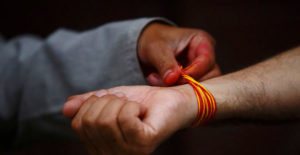 The day also marks another holy festival Rakshya Bandhan when men, women, and children regardless of station and caste tie Doro (a sacred yellow thread) around their wrist as a symbol of protection from fear and disease. Raksha means protection and Bandhan means a bond, hence, the Doro is tied by a Hindu priest intoning a quick prayer which goes, ‘Thus I tie the Raksha around your wrist, the same which bound the arm of the mighty Bali, King of the Danavas. May its protection be eternal.’ With a belief of bringing good luck, the entire family gathers around a priest to tie the sacred thread; men tie the thread around their right wrist and the women tie it on their left wrist. It is believed that this thread should only be removed on Laxmi Puja, which falls three months later and tied to the tail of a cow. Thus when death comes to the wearer the cow will help him/her to cross the river Bhaitarna, by allowing the dead to cling to her tail.
The day also marks another holy festival Rakshya Bandhan when men, women, and children regardless of station and caste tie Doro (a sacred yellow thread) around their wrist as a symbol of protection from fear and disease. Raksha means protection and Bandhan means a bond, hence, the Doro is tied by a Hindu priest intoning a quick prayer which goes, ‘Thus I tie the Raksha around your wrist, the same which bound the arm of the mighty Bali, King of the Danavas. May its protection be eternal.’ With a belief of bringing good luck, the entire family gathers around a priest to tie the sacred thread; men tie the thread around their right wrist and the women tie it on their left wrist. It is believed that this thread should only be removed on Laxmi Puja, which falls three months later and tied to the tail of a cow. Thus when death comes to the wearer the cow will help him/her to cross the river Bhaitarna, by allowing the dead to cling to her tail.Many legends are associated with this pious festival and among them; the myth of Bali is widely imitated on a propitious day. The day might be a reminder of the extraordinary acts of charity performed by King Bali- the king of Danavas (demons). The King had taken the vow of charity, according to which he would grant every wish made to him. His deep devotion and boundless benevolence won him a place higher than Lord Indra- King of heaven. Seeing their realm under a demon, the gods prayed to Lord Vishnu. The Lord came to their assistance disguised as a dwarf and begged Bali for as much land as he could cover in three strides. After Bali’s agreement, the dwarfed Vishnu swelled to the size of a tremendous giant and in two mighty strides stepped across Heaven and Earth. When he demanded where he might take the promised third step, Bali who had already recognized Vishnu placed the giant’s foot atop his own head and was pushed far into the bowels of the earth. In this way, Lord Vishnu restored the three worlds to the rightful ruling gods, and repaid Bali for his last act of earthly charity, by making him the King of the underworld, where he is believed to be still ruling.
To mark the day, Hindu pilgrims visit Gosaikunda, a holy shrine of Lord Shiva, situated at mountains north of Kathmandu, and take a dip in the sacred lake with a belief of purging their sins. As part of the Janai Purnima celebration, a grand festival takes place at Kumbeshwor Mahadev Temple in Patan. An idol of Lord Shiva is placed in the middle of the pond of Kumbeshwor where people take a plunge, perform puja, and watch religious fairs.
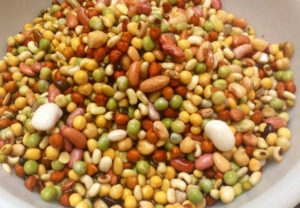 On the day, a special dish – Kwati- a soup prepared from nine different beans, and different variety of traditional Nepali food is served at home. The soup is highly nutritious which keeps diseases away and all family members come together to eat Kwati and to celebrate the festival.
On the day, a special dish – Kwati- a soup prepared from nine different beans, and different variety of traditional Nepali food is served at home. The soup is highly nutritious which keeps diseases away and all family members come together to eat Kwati and to celebrate the festival.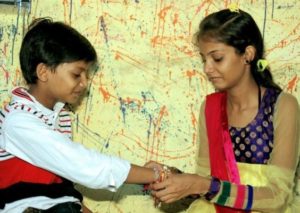 Moreover, the Newar community marks the same day as the beginning of the nine-day festival called Gunhu Punhi. The Newars coat the threshold of their houses with mud and offer food to gods and food and bougainvillea (Gunakeshari flower) to frogs on banana leaves. Likewise, in the Terai region, the day is celebrated as Rakhi festival when sisters tie Rakhi (a thread signifying bond of protection) around their brothers’ wrists wishing them long life and prosperity and in turn, brothers give gifts to their sisters as an assurance of protecting them from all impediments in life. The colorful festival of Janai Purnima observes the bond of purity and security.
Moreover, the Newar community marks the same day as the beginning of the nine-day festival called Gunhu Punhi. The Newars coat the threshold of their houses with mud and offer food to gods and food and bougainvillea (Gunakeshari flower) to frogs on banana leaves. Likewise, in the Terai region, the day is celebrated as Rakhi festival when sisters tie Rakhi (a thread signifying bond of protection) around their brothers’ wrists wishing them long life and prosperity and in turn, brothers give gifts to their sisters as an assurance of protecting them from all impediments in life. The colorful festival of Janai Purnima observes the bond of purity and security.As Janai Purnima is on the way, iMartNepal dot com provides you various kinds of handicrafts items that you can gift to your siblings and relatives. It helps you to celebrate Janai Purnima in Nepali traditional style and culture. We express our warm wishes to you all on the special occasion of Janai Purnima.
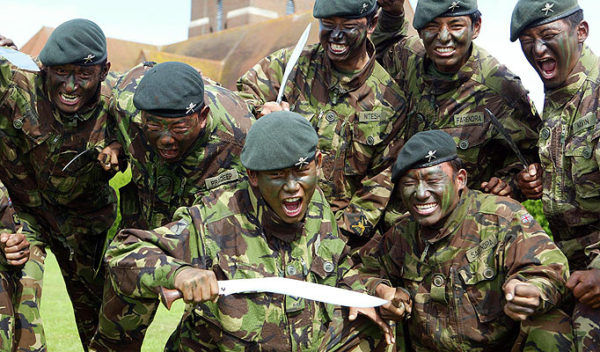
The history of Gurkhas and Khukuri
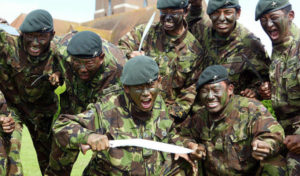
“Better to die than be a coward” is the motto of the world-famous Nepalese Gurkha soldiers who are an integral part of the British Army. They still carry into battle their traditional weapon curved knife known as the Khukuri.In times past, it was said that once a Khukuri was drawn in battle, it had to “taste blood” – if not, its owner had to cut himself before returning it to its sheath.
The potential of these warriors was first realised by the British at the height of their empire-building in the last century. The Victorians identified them as a “martial race”, perceiving in them particularly masculine qualities of toughness. Bravest of the brave, most generous of the generous, never had a country more faithful friends than you Sir Ralph Turner MC, 3rd Queen Alexandra’s Own Gurkha Rifles, 1931. After suffering heavy casualties in the invasion of Nepal, the British East India Company signed a hasty peace deal in 1815, which also allowed it to recruit from the ranks of the former enemy.Following the partition of India in 1947, an agreement between Nepal, India and Britain meant four Gurkha regiments from the Indian army were transferred to the British Army, eventually becoming the Gurkha Brigade.
Since then, the Gurkhas have loyally fought for the British all over the world, receiving 13 Victoria Crosses between them.PIC: Balbhadra Kunwar on the Nalapani War.
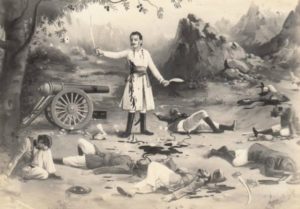
It is a medium-length curved knife each Gurkha soldier carries with him in uniform and in battle. In his grip, it is a formidable razor-shape weapon and a cutting tool. In fact, it is an extension of his arm. When his rifle misfires, or when his bullets have run out, a Gurkha unsheathes his Khukuri and makes his final “do-ir-die” run on the enemy in a fury to finish the business. This scene created the romance and the legends. The Khukuri is carried in a wooden (often leather covered) stealth.
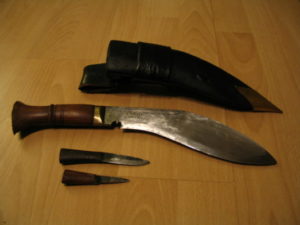
Khukuri is the national knife of Nepal, originating in ancient times. It is all-purpose knife of the hill peoples of Nepal, especially the Magars and Gurungs in the west, and the Rais and Limbus in the east.The name and fame of khukuri is so exceptional and not only because it is one very efficient and excellent knife but the myths it carries within and its religious values have literally made this knife a true legend. Nepalese are commonly recognized as Gurkhas because of their bravery and solidarity. Each and every Nepalese keeps Khukuri in their homes for the protection. iMartNepal provides various ranges of Khukuris to all Nepalese living in abroad.
You can also buy Khukuri for decoration and protection.
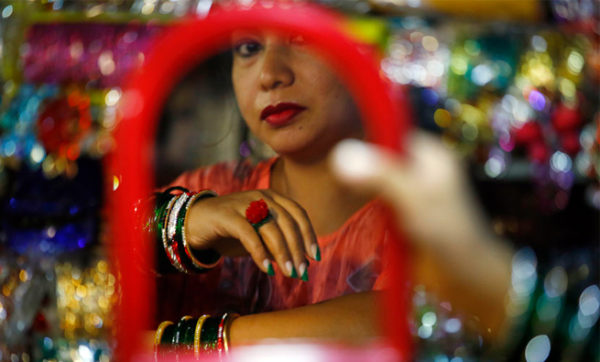
Sales of Festival Items Soar During Holy Month
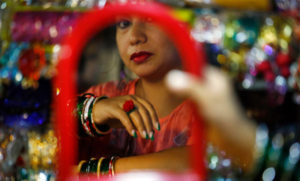
With the start of the holy month of Shrawan, Kathmandu’s streets are swarming with excited women and girls buying green and yellow bangles, materials to apply henna tattoo and beads. Devotees mark the sacred month by wearing special clothes and adorning their bodies, and sales of festival paraphernalia soar this time of the year. “We see the highest sales during the start of the festive season in Shrawan,” said Alsha Prajapati, a cosmetics shop owner at Asan. “More than 40 percent of our annual sales happen during the months of Shrawan, Bhadra and Ashwin.” According to Prajapati, prices of glass bangles range from Rs30 per dozen to Rs.300 per dozen while metal bangles cost from Rs.150 per dozen to Rs.1,000 per dozen.
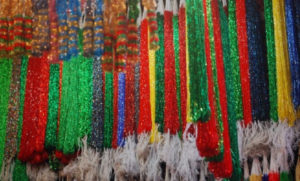
“The practice of giving bangles and beads as gifts has also developed in recent years result- ing in higher sales,” said Prajapati. Plastic and metal bangles cost more than glass bangles as they are more durable. This has led to an increase in demand for plastic and metal bangles in recent years. Likewise, sales of beads have also taken off. Wearing green and yellow beads is synonymous with the arrival of Shrawan for Hindu women. Prices start at Rs.50. Also sales of Tilhari and Pote rises in this month. Hindu devotees in Nepal cele- brate Shrawan as the month of Lord Shiva and observe the tradi- tion of wearing green bangles, henna tattoos and necklaces. Women and girls of different age groups can be seen on the streets decked out in festival finery. According to Prajapati, women of all age groups throng the bazaar to buy bangles and other items. “Wearing bangles and henna tattoos is fun and adds a fashion- able twist to everyday wear,” said Rishu Basnet, a student. Nepali womens paint mehendi in their hands during the month of Shrawan. It costs from Rs.200 to Rs.1000, provides sufficient revenue for cosmetic owners. Women are benefited by their own capability, somewhat relates to women empowerment.
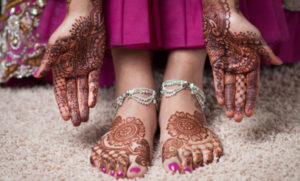
“The beautiful henna tinges are trendy. Moreover, the month of Shrawan is believed to bring good fortune to those who wear henna tattoos.” Henna artists have set up mini stalls on the busy streets of Kathmandu like New Road, Sundhara, Asan and Lagankhel, among other places. According to traders, most of the bangles, beads and henna kits are imported from Birgunj and other districts of Terai.

Go Green: Lets act Eco-friendly – iMartNepal

In these days, terms like “going green” and “eco-friendly” have become buzz words on talk shows, commercials and product packaging. Eco-friendly literally means earth-friendly or not harmful to the environment. This term most commonly refers to products that contribute to green living or practices that help conserve resources like water and energy. Eco-friendly products also prevent contributions to air, water and land pollution. You can engage in eco-friendly habits or practices by being more conscious of how you use resources.
The usage of more resources and unwanted materials has caused pollution of air, water, land and sound. Due to excessive pollution, the average temperature of the earth is increasing day to day which has caused global warming, climate change and acid rainfall. The items and products we use should be made using eco friendly materials. iMartNepal sells only the eco friendly products as we concern for betterment of our planet earth. Choice of one people makes differences in the life of global community all over the globe.
The truth is that everything single thing we do every day has an impact on the planet either good or bad. The good news is that as an individual you have the power to control most of your choices and, therefore, the impact you create: from where you live to what you buy, eat, and use to light your home to where and how you vacation, to how you shop or vote, you can have global impact.
What are Eco-Friendly Products?
Eco-friendly products are those products that do not harm the environment whether in their production, use or disposal. Making a truly eco-friendly product keeps both environmental and human safety in mind.Eco-friendly products can be made from scratch, or from recycled materials. This kind of product is easily recognizable as it is, in most cases, labelled as such.
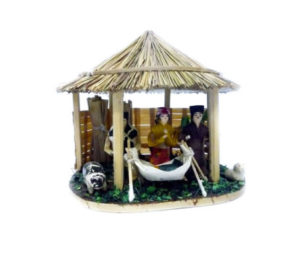
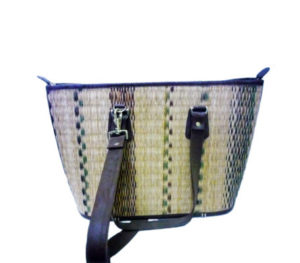
We have a limited amount of resources available and more and more people using them up. If we want our future generations to enjoy the same standard of living we’ve experienced, we need to take action. Buy eco friendly products from today.
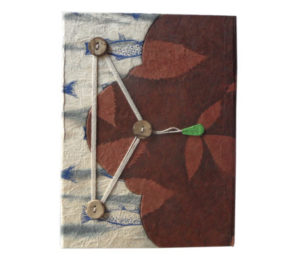
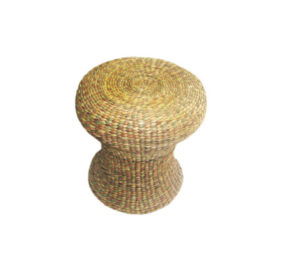
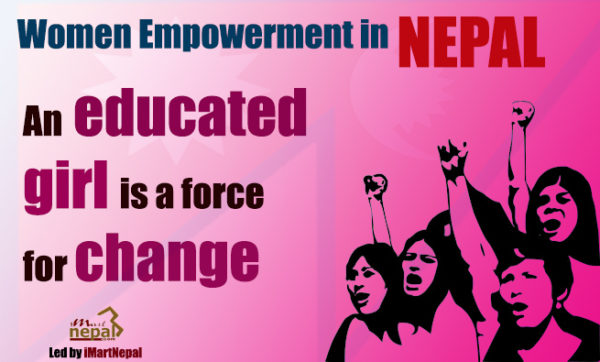
Women Empowerment in Nepal
*Introduction**
Women empowerment is not just a global issue but a significant challenge in developing countries like Nepal. In a society where patriarchal norms often dictate women’s roles and opportunities, empowerment becomes a critical pathway to gender equality and social change.

**The Current Scenario**
Nepal’s cultural landscape is rich and diverse, but it also harbors deep-rooted gender biases. Women are often relegated to secondary roles, confined to household chores, and denied access to education and employment.
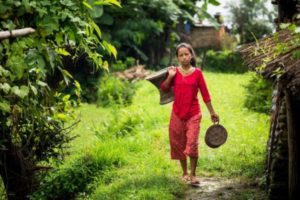
**Challenges Faced by Women in Nepal**
- **Societal Constraints**: Traditional beliefs often limit women’s roles to domestic spheres, hindering their participation in public life.
- **Lack of Education**: The conservative mindset has led to a low literacy rate among women, especially in rural areas.
- **Financial Dependence**: Without proper education and job opportunities, women remain financially dependent, lacking autonomy and decision-making power.
- **Health and Safety Concerns**: Women’s health and safety are often compromised, with limited access to healthcare and increased vulnerability to domestic violence.
**Efforts to Empower Women**
Various organizations and governmental bodies are working to empower women in Nepal:
- **Non-Formal Education**: Tailored programs to educate women who missed formal schooling.
- **Income-Generating Training**: Skill development initiatives to enable women to earn a livelihood.
- **Legal Awareness**: Workshops and campaigns to inform women of their legal rights and protections.
- **Community Engagement**: Encouraging community participation to change societal attitudes towards women.
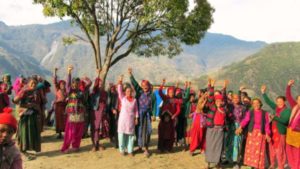
**The Impact of Empowerment Programs**
The concerted efforts are leading to:
- **Increased Literacy**: More women are accessing education, leading to higher literacy rates.
- **Economic Independence**: Women are engaging in income-generating activities, gaining financial independence.
- **Social Change**: Gradual shifts in societal attitudes are allowing women more freedom and respect.
- **Political Participation**: More women are taking part in local governance and decision-making processes.
**Case Study: The Women’s Foundation Nepal’s Scholarship Program**The Women’s Foundation Nepal (WFN) is actively working to break the cycle of poverty in Nepal by providing educational scholarships to children from underprivileged families. Recognizing the extreme poverty that many families face, which often forces children into labor at a young age, WFN has taken significant steps to ensure that education is accessible to all.
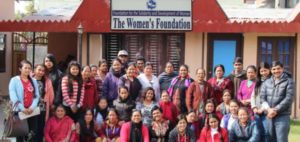
**Program Overview**
WFN’s scholarship program covers tuition fees, uniforms, and essential school supplies, enabling children to pursue their educational aspirations without financial burdens. The program is transformative, not only providing immediate educational opportunities but also laying the foundation for promising employment in the future.

**Impact**
- **Breaking the Cycle of Poverty**: By granting access to education, WFN enables children to enjoy their childhood and grow into adults who can independently provide for their families, including their children’s education.
- **Supporting Women and Children**: WFN’s sponsorship and scholarship programs also cover living and education costs for women and children from the Shelter Home, including shelter, food, healthcare, and skills training.
- **Widespread Reach**: The Women’s Foundation Nepal provides scholarships for more than 1,000 children belonging to poor families all over Nepal, changing the cycle of poverty and creating better lives.
**Personal Connection**
Those who contribute to the scholarship program are kept updated regularly on the child’s educational journey. WFN also furnishes comprehensive background information about the family and the child being supported, creating a personal connection between the donor and the recipient.
**Other Case Studies and Success Stories**
– **Women’s Cooperatives**: Many women have formed cooperatives, engaging in small-scale businesses and supporting each other.
– **Healthcare Initiatives**: Female community health volunteers are playing a crucial role in rural healthcare.
– **Educational Scholarships**: Special scholarships for girls are encouraging more families to send their daughters to school.

**Conclusion**
Women empowerment in Nepal is a journey filled with challenges and triumphs. The path is fraught with obstacles, but the relentless efforts of various organizations, communities, and individuals are making a difference. The focus on education, economic independence, legal awareness, and community engagement is paving the way for a more equitable and just society.

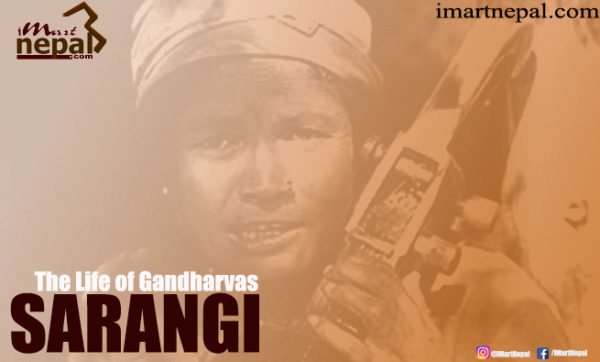
Sarangi | Musical Instruments
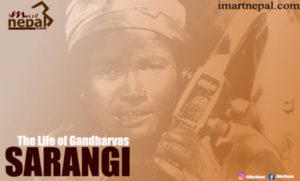
Sarangi – Nepali Musical Instrument
Sarangi is a traditional folk musical instrument of Gandharva community of Kaski district.Sarangi is also found in Indian classical music but the Sarangi of Nepal has only 4 strings. Traditionally it was played by only the Gaine or Gandarva caste. Today it has found its way to more main stream Nepali music.
Sarangi is made from a hollowed-out wooden piece with 2 chambers. Both pieces are made from soft wood call Khiro. It is played by rubbing the strings by a bow. The string was originally made from sheep intestine. The fine nerves of the intestine was used after the external meat was rotted out to make strings. These days nylon, PVC and steel strings are also used for this purpose.The bow was traditionally strung with horse tail-hair (as used in violin bows), but in the modern day nylon bowstrings are common. The bow handle is usually made by bamboo. Different notes are made by touching the strings with the nail of fingers of the left hand.It is taken as a instrument to express emotions through music.You can see many Gaine singers singing in the streets of Kathmandu and the villages. They still sing for their daily upkeep and also sell the instruments to make a living.
Who are Gandharvas/Gaines ?
Over the centuries, the Gaine or Gandharva, a community of occupational caste musicians, functioned as the sole organised means of information and entertainment for the numerous isolated communities across the mountains of Nepal. In ancient time, the Gaine travelled from village to village, singing about everything from legendary heroes and ongoing battles to tales of what they saw on their journeys and the lives of the people they encountered on their way. In a society where access to information was considered the exclusive right of the ‘high’ caste and the wealthy, the Gaine’s function was crucial.
Today, the traditional storyteller function of the Gaine has been losing relevance rapidly in the rural areas. This is already evident, with the Gaines migrating to the cities in large numbers. In the urban centres of Kathmandu and Pokhara, the Gaine now roam the tourist areas, hoping to make money by playing tunes for the tourists or selling them a Sarangi.
As craze of western musical instruments like Guitar, Piano, Drums etc. has been growing in the minds of younger ones, the value of folk instruments is reduced. It is the resposibility of every citizens of Nepal to save and promote the traditional musical instruments along with Sarangi. We,iMartNepalare promoting the traditional arts, handicrafts and musical instruments of Nepal through different media. If we contribute a little from our side then it will surely bring changes in the thoughts of younger ones and as a result, Nepali art and musical instruments will get reknown popularity in global community.
Love Nepali Instrument, Love Nepal.
You can buy Sarangi online at iMartNepal.
